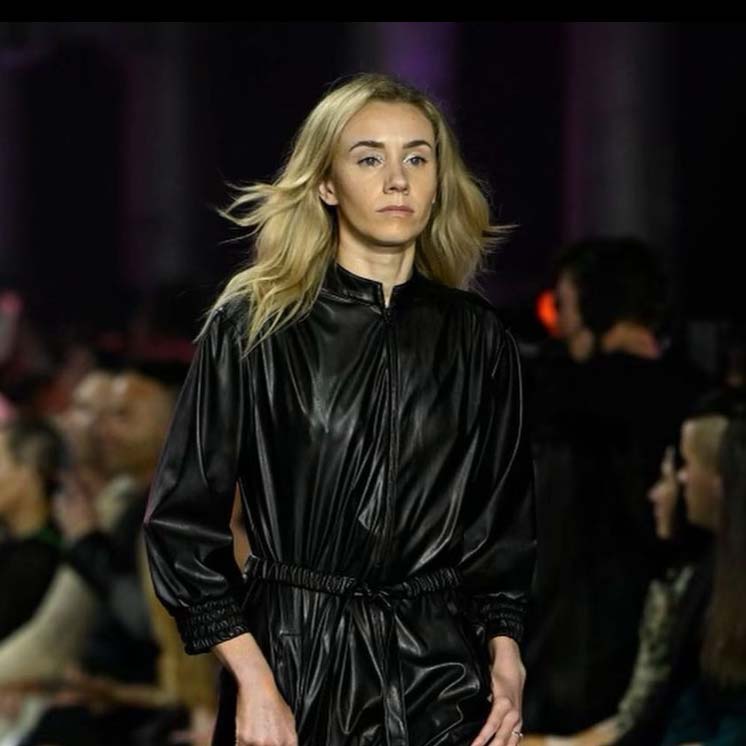Stephanie Kelly is a chronic illness advocate and ‘tubie’ with a TikTok following of 44,900, determined to use her lived experience to change perceptions and create communities. Stephanie walked for Bondi Born, Manning Cartel and Blanca in the ‘Future of Fashion’ Show at Australian Fashion Week 2022, promoting diversity and inclusion on the runway. The Sydney based model and advocate is represented by Champion Health Agency, and sits down with Forward Ability Support to answer questions for Feeding Tube Awareness Week:
What is your experience using a feeding tube?
I have had feeding tubes for 4 years now. My very first feeding tube was a Naso-jejunal (NJ) tube that went down into my Jejunum (small intestine) by-passing my stomach that was not functioning. I was also given a Naso-gastric (NG) tube to drain the contents of my stomach. These tubes helped my condition so much that they placed a long-term tube called a PEGJ which was a two-in-one tube, placed directly through my abdomen into my stomach and had an extension into my jejunum. Due to complications, I had a separate tube placed into my small intestine called a PEJ, this meant that the J extension of the GJ was removed and turned my PEGJ into a PEG! I now have two tubes in my abdomen that I use every day, multiple times a day, for gastric drainage + placing medication and enteral feeds into my small intestine.

Did you have a transition from solid food to enteral feed? How did you find this?
I transitioned quite quickly from solid food to enteral feed. Due to my worsening condition, within a month or two I went from eating regular food to only being able to tolerate feed via my feeding tubes. The hardest part of transitioning was having to explain to friends and family that I couldn’t eat and that I was still able to meet my nutrition needs via my feeding tubes. It also impacted me socially as I no longer wanted to go out.
Do you have any advice for someone starting using a feeding tube or a loved one with a feeding tube?
My advice to somebody starting their feeding tube journey, would be to ride the wave of being overwhelmed for the first few weeks. Being overwhelmed is totally normal and it happens to the best of us! Personally, being a paediatric nurse who had worked with children with these exact tubes, syringes, pumps, and formula’s – even I was super overwhelmed! There is a beautiful ‘tubie’ community online in support groups, forums and Instagram pages with tips and tricks and advice for new tubies. Never be afraid to ask for advice and remember that it is hard to adapt to a new way of life!

What were some of the challenges?
I found it challenging to remember all the daily routines needed to maintain the feeding tubes – flushes, turning the tube, cleaning the tube etc. Writing it all down and having a routine helped. I also found it tough learning to navigate socialising around food when all I could do was drink liquid or when I’d be attached to a backpack with formula and a pump in it! These challenges I quickly adjusted to, and after about 6 months I found my feeding tubes an easy part of my life!
Do you still use a feeding tube?
I still use my PEG + PEJ. Because my stomach is paralysed it cannot empty its contents into my small intestine, and therefore I need to empty it manually via the G tube. My J tube is used primarily for medication administration and enteral feeds given via a pump.
What do you want people to know about feeding tubes that they might not know previously? What are some misconceptions about it?
Some misconceptions about feeding tubes are that there is only one type of feeding tube, whereas in reality there are so many types, brands, and placements of tubes! There is also not just one condition that requires the assistance of feeding tubes – there are over 4,000 conditions where feeding tubes can be used. Another is that a lot of people think that if you need a feeding tube that means you cannot eat at all – however most tube users eat what they can tolerate, or what they feel like and that either may not digest/absorb or it may not be enough for their daily intake, and they therefore need the feeding tube to supplement their nutrition.
